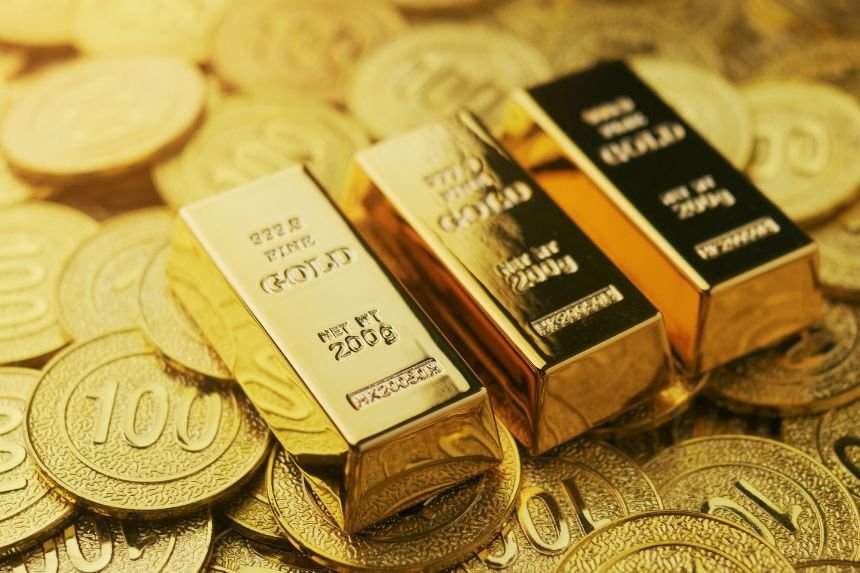The ongoing increase in gold prices continues to capture global attention as investors evaluate economic data, central bank actions, and geopolitical risks. Spot gold has climbed past $4,200 per ounce, reflecting expectations of a December interest rate cut, a weaker U.S. dollar, and rising safe-haven demand amid economic uncertainty.
- Primary Drivers Behind the Gold Market Rally
- Gold Price Surge Past $3,900 and Record Levels
- Technical Analysis of Gold Price Surge
- Global Drivers of the Gold Market Rally
- Gold Price Surge Prediction and Future Outlook
- Silver and Other Metals Track Gold Rally
- Historical Context and Comparison
- Why the Gold Market Rally Is Unusual
- Conclusion: Gold Market Rally Remains a Key Theme
- FAQs
Following the record 43-day U.S. government shutdown, delayed economic data is being released. Investors are closely monitoring these reports to gauge the strength of the labor market, inflation trends, and the broader economy. The uncertainty created by the shutdown has amplified the current bullion surge, driving both retail and institutional interest.
This year, gold has experienced remarkable gains, with a rally of over 60% in 2024, reaching record highs of $4,381.21 per ounce. Platforms like Kitco have highlighted this as one of the most unusual and significant gold market rallies in recent history.
Primary Drivers Behind the Gold Market Rally
U.S. Government Reopening Boosts Gold
The reopening of the U.S. government after the shutdown has provided a major boost to the precious metal rally. Employment and inflation data are finally reaching the market, giving investors updated insights. Analysts suggest that if this data confirms labor market weakness, it could further support Federal Reserve rate cuts, reinforcing the ongoing gold market rally.
The shutdown created a vacuum in official economic reporting, leaving investors and policymakers reliant on private surveys like the ADP jobs report, which showed significant job losses. This lack of transparency increased uncertainty, making gold a natural choice for risk-averse investors.
Safe-Haven Demand and Investor Behavior
Investors are increasingly turning to gold as a hedge against uncertainty. Heightened concerns over global fiscal stability, currency fluctuations, and geopolitical tensions have elevated safe-haven demand, pushing prices higher. Events like Moody’s downgrade of the U.S. credit outlook have reinforced the perception of gold as a reliable store of value.
Trump National Guard Deployment Blocked in Portland by Judge
Weaker Dollar and Bond Yields
The U.S. dollar has softened, making gold more attractive internationally. Lower Treasury yields reduce the opportunity cost of holding non-yielding assets, adding to bullish momentum. These conditions support the ongoing bullion surge and encourage both short-term trading and long-term investment.
Central Bank Buying and ETF Inflows
Global central banks have been actively increasing gold reserves, while ETFs have experienced large inflows. These structural trends provide additional support for gold prices beyond conventional economic drivers. The combination of central bank accumulation and ETF demand has been a key factor behind the sustained precious metal rally, helping it surpass historical levels.
Gold Price Surge Past $3,900 and Record Levels
Gold recently surged past $3,900 and has now breached $4,200 per ounce. This performance is among the strongest in years, reflecting both macroeconomic concerns and investor sentiment. Analysts suggest that if uncertainty persists, the metal could retest the all-time high near $4,382, marking a historically significant increase in gold prices.
Regional Impact of the Gold Market Rally
The rally has reverberated across global markets. MCX, Dubai, Kuwait, and India have mirrored U.S. gains. In India, cities like Hyderabad, Chennai, and Bangalore have experienced significant price jumps, while Nepal and Sri Lanka have seen similar increases. These trends underscore how interconnected global gold markets are and how U.S. policy and economic data influence local markets worldwide.
Investor Behavior in Response to the Rally
Investors are not only reacting to macroeconomic news but also making strategic portfolio adjustments. Many are shifting from equities and bonds into gold to hedge against inflation, market volatility, and currency risks. The ongoing gold rally amid trade uncertainty also highlights how precious metals can act as a buffer during turbulent market conditions.
Technical Analysis of Gold Price Surge
Short-Term Uptrend Indicators
The gold market rally chart shows a strong short-term uptrend, with the Relative Strength Index (RSI) above neutral 50, indicating ongoing buying momentum. The MACD histogram shows bullish crossover patterns, signaling that the upward trend is likely to continue.
Support and Resistance Levels
Technical analysis shows intermediate support around $4,124, with critical psychological support at $4,000. Resistance is observed near $4,382, marking a key level for traders. Historical trends indicate typical annual gains of around 10%, making the current bullion surge unusual in its magnitude. Visit our homepage for more information.
Global Drivers of the Gold Market Rally
Trade Tensions and Geopolitical Risks
Rising trade disputes and geopolitical concerns have contributed to the gold rally amid trade uncertainty. Uncertainty surrounding tariffs, trade agreements, and global policy increases demand for safe-haven assets, fueling the upward momentum.
Currency Depreciation and Economic Fears
Weakening major currencies have made gold increasingly appealing. Events such as Moody’s downgrade of the U.S. credit rating have amplified global concern, reinforcing the ongoing precious metal rally.
ETF Flows and Investment Demand
ETF inflows and physical bullion purchases have driven investment in gold. This has also contributed to the gold and silver price surge, where silver often mirrors gold’s movements with amplified volatility. Investors have realized significant investment gains during gold market rallies, reflecting hedging strategies and speculative positioning.
Regional Trends
Regional markets, including Hyderabad, Chennai, Bangalore, Nepal, Sri Lanka, and Dubai, have closely tracked the global rally. Historical spikes, such as the April 17 and June 6 Hyderabad gold price surge, show that local markets are highly sensitive to international trends, emphasizing gold’s global appeal.
Gold Price Surge Prediction and Future Outlook
Short-Term Forecast
Analysts expect the gold market rally prediction to continue if the Federal Reserve signals further easing or if labor market weakness persists. Delayed economic data may provide additional support for gold as a safe-haven investment.
Long-Term Forecast
Over the next five years, structural factors like rising U.S. debt, persistent inflation, and global uncertainty suggest continued momentum in bullion prices. Historical trends and 10-year gold price charts indicate that while temporary corrections may occur, the long-term outlook remains bullish.
Global Investment Strategies
Investors are advised to maintain gold as part of a diversified portfolio. Rising geopolitical tensions, trade uncertainties, and currency fluctuations all support the ongoing precious metal rally, making it a reliable hedge and central component of risk management strategies.
Silver and Other Metals Track Gold Rally
Silver’s Performance
Silver has surged over 4.5%, surpassing $50, and reaching levels not seen since September 2024. This reflects the typical gold and silver price correlation, where silver reacts more sharply to economic developments and investor sentiment.
Platinum and Palladium Trends
Platinum has risen approximately 1%, while palladium has gained 1.4%. These metals benefit from both industrial demand and safe-haven flows, underscoring the broader precious metals rally.
Historical Context and Comparison
Gold has long served as a hedge against inflation, economic turmoil, and currency debasement. The current gold market rally is unusual in both speed and magnitude, surpassing previous rallies that were primarily driven by interest rate cuts, dollar weakness, or geopolitical shocks. Today’s surge is supported by ETF inflows, central bank purchases, and global investor demand.
Why the Gold Market Rally Is Unusual
The rapid pace and multi-faceted drivers of this rally make it historically significant. Gains exceeding 60% year-to-date are supported by central bank accumulation, ETF inflows, and safe-haven demand. Regional responses in Hyderabad, Chennai, Bangalore, Nepal, Sri Lanka, and Dubai further highlight the global influence of the bullion surge today.
Speculative positioning, combined with macroeconomic uncertainty, has contributed to its unusual nature. Analysts note that the correlation between gold’s rise and investor hedging behavior underscores the importance of maintaining exposure to precious metals.
Conclusion: Gold Market Rally Remains a Key Theme
The ongoing gold market rally highlights its continued relevance as a safe-haven asset amid global uncertainty. With the U.S. government reopening and economic data being released, gold continues to be a focal point for investors.
Regional trends in Hyderabad, Chennai, Dubai, Bangalore, and Sri Lanka, combined with strong ETF inflows and central bank purchases, indicate that the increase in gold prices today is likely to persist. Investors will continue monitoring labor market reports, Fed statements, and geopolitical developments to evaluate the future trajectory of this historically significant rally.
FAQs
Q1: Why is the gold price rising?
Gold prices are rising due to safe-haven demand, a weaker U.S. dollar, expectations of Fed rate cuts, and economic uncertainty following the U.S. government shutdown.
Q2: Will gold go to $5,000 an ounce?
While $5,000 is possible under extreme economic or geopolitical stress, most analysts expect gradual gains driven by inflation, currency depreciation, and continued investor demand.
Q3: How much for 1 oz of gold right now?
Currently, 1 ounce of gold is trading above $4,200, with prices fluctuating daily based on global economic conditions and market sentiment.
Q4: What will gold be worth in 5 years?
Gold is expected to trend higher over the next five years, potentially reaching $5,000 or more, driven by inflation, global debt levels, and sustained safe-haven demand.








